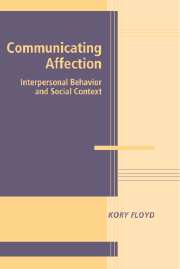Book contents
- Frontmatter
- Contents
- List of Tables
- List of Figures
- Foreword
- 1 AN INTRODUCTION TO AFFECTIONATE COMMUNICATION
- 2 THINKING ABOUT AFFECTION: THE THEORIES
- 3 ENCODING AFFECTIONATE MESSAGES
- 4 DECODING AND RESPONDING TO AFFECTIONATE EXPRESSIONS
- 5 BENEFITS OF EXPRESSING AND RECEIVING AFFECTION
- 6 RISKS ASSOCIATED WITH AFFECTIONATE COMMUNICATION
- 7 A NEW THEORETIC APPROACH
- 8 AFFECTIONATE COMMUNICATION IN HUMAN INTERACTION
- References
- Index
Foreword
Published online by Cambridge University Press: 02 December 2009
- Frontmatter
- Contents
- List of Tables
- List of Figures
- Foreword
- 1 AN INTRODUCTION TO AFFECTIONATE COMMUNICATION
- 2 THINKING ABOUT AFFECTION: THE THEORIES
- 3 ENCODING AFFECTIONATE MESSAGES
- 4 DECODING AND RESPONDING TO AFFECTIONATE EXPRESSIONS
- 5 BENEFITS OF EXPRESSING AND RECEIVING AFFECTION
- 6 RISKS ASSOCIATED WITH AFFECTIONATE COMMUNICATION
- 7 A NEW THEORETIC APPROACH
- 8 AFFECTIONATE COMMUNICATION IN HUMAN INTERACTION
- References
- Index
Summary
Talk not of wasted affection; affection never was wasted.
– Henry Wadsworth LongfellowIn virtually every typology of fundamental human needs, one finds mention of affection. Humans don't just love to be loved; we need to be loved. And, perhaps equally as important, we need to be shown that we are loved. This latter need, and the processes by which we meet it, are the focus of this text.
The communication of affection – the process of expressing our care, appreciation, value, and love for others – is so ingrained a part of the human social experience that it is fairly easy to overlook. We communicate affection to friends when they are feeling low, as a means of providing comfort and emotional support. We express affection to our children as a way of making them feel loved, cared for, and protected. We convey affection to potential romantic partners in order to signal our attraction, and to current romantic partners as a means of reinforcing the strength of our pair bonds. We can even behave affectionately toward people for whom we have no genuine feelings of affection, as a way to manipulate their behaviors, attitudes, or emotions. Affectionate communication is a ubiquitous aspect of human relational interaction – its presence can be the source of unparalleled joy; its absence can be the cause of pain and distress.
- Type
- Chapter
- Information
- Communicating AffectionInterpersonal Behavior and Social Context, pp. xiii - xivPublisher: Cambridge University PressPrint publication year: 2006



